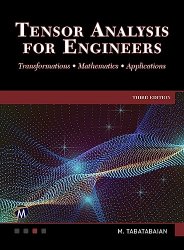Tensor Analysis for Engineers: Transformations - Mathematics - Applications, 3rd Edition
- Добавил: literator
- Дата: 20-08-2023, 22:50
- Комментариев: 0
 Название: Tensor Analysis for Engineers: Transformations - Mathematics - Applications, 3rd Edition
Название: Tensor Analysis for Engineers: Transformations - Mathematics - Applications, 3rd EditionАвтор: Mehrzad Tabatabaian
Издательство: Mercury Learning and Information
Год: 2023
Страниц: 251
Язык: английский
Формат: pdf (true)
Размер: 10.2 MB
Tensor analysis is used in engineering and science. This new edition introduces engineers and applied scientists to the tools and techniques of tensor analysis so that they can apply them to practical problems and analysis. In addition, the edition includes extensive material on the application of mechanical stress transformations. Geometry is restricted to Euclidean space/geometry in which Pythagoras' theorem applies and is based on a well-defined Cartesian coordinate system. For quantities defined in curvilinear coordinate systems such as cylinders, spheres, and parabolas, examples, coordinate sketches, and corresponding calculations are given. In addition, the book contains several worked examples to help the reader master the topics covered in the previous sections.
This is the third edition of the published textbook: Tensor Analysis for Engineers. In this edition, we have expanded the content on the application of mechanical stress transformation. We include topics like 2D and 3D stress tensor transformation, Mohr’s circle graphical method, and octahedral shear stress with applications in static failure theories for solid media. We added several worked-out numerical examples related to the above-mentioned topics.
In engineering and science physical quantities are often represented by mathematical functions, namely tensors. Examples include temperature, pressure, force, mechanical stress, electric/magnetic fields, velocity, enthalpy, entropy, etc. In turn, tensors are categorized based on their rank, i.e. rank zero, one, and so forth. The so-called scalar quantities (e.g. temperature) are tensors of rank zero. Likewise, velocity and force are tensors of rank one and mechanical stress and gradient of velocity are tensors of rank two. In Euclidean space, which could be of dimension , we can define several coordinate systems for our calculation and measurement of physical quantities. For example, in a 3D space, we can have Cartesian, cylindrical, and spherical coordinate systems. In general, we prefer defining a coordinate system whose coordinate surfaces (where one of the coordinate variables is invariant or remains constant) match to the physical problem geometry at hand. This enables us to easily define the boundary conditions of the physical problem to the related governing equations, written in terms of the selected coordinate system. This action requires transformation of the tensor quantities and their related derivatives (e.g., gradient, curl, divergence) from Cartesian to the selected coordinate system or vice versa.
Features:
Expanded content on the application of mechanical stress transformation
Covers rigid body rotation and Cartesian tensors by including Euler angles and quaternion methods
Uses easy to understand mathematical concepts through numerous figures, solved examples, and exercises
Lists gradient-like operators for major systems of coordinates and rotation matrices for proper Euler and Tait-Bryan angles
Скачать Tensor Analysis for Engineers: Transformations - Mathematics - Applications, 3rd Edition
[related-news] [/related-news]
Внимание
Уважаемый посетитель, Вы зашли на сайт как незарегистрированный пользователь.
Мы рекомендуем Вам зарегистрироваться либо войти на сайт под своим именем.
Уважаемый посетитель, Вы зашли на сайт как незарегистрированный пользователь.
Мы рекомендуем Вам зарегистрироваться либо войти на сайт под своим именем.
